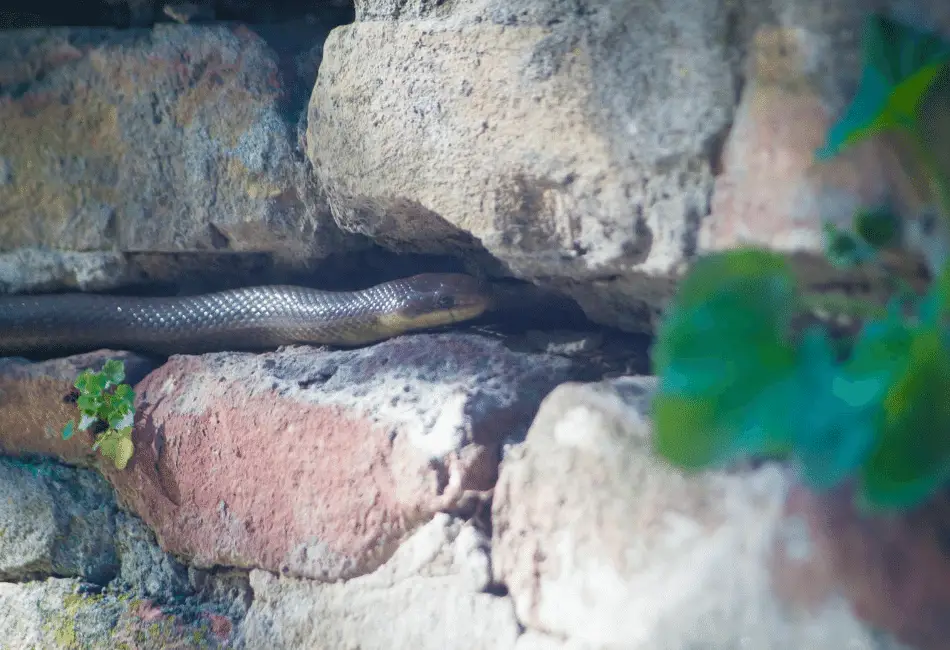The common image of a snakes that we see are ones where they are slithering along the ground, coiled up, or maybe hiding in the brush. Most people do not associate snakes with climbing tasks given their obvious lack of legs and feet like raccoons who are known to easily climb fences.
However, an interesting question is if snakes can climb things like walls and stairs given the structure of their bodies. This is an important question to answer for homeowners who are concerned with the ability of snakes to access their home or yard through climbing.
Certainly, most people do not want to be surprised by a snake in an unsuspecting location such as the roof, attic, or an upstairs bedroom. This is especially true for people who live in an area where snakes are poisonous or harmful.
Snakes Ability To Climb
Snakes can climb walls and stairs. As explained by livescience.com, research shows that snakes use both their scales and muscles to press against a surface to move upward. The many scales on snakes are able to angle to allow ample friction on a vertical surface to allow them to grip and climb.
The surface snakes climb needs to allow for grip. In other words, snakes will have a difficult time making their way up a smooth surface. An object like a smooth metal wall is nearly impossible for a snake to climb.
Additionally, the average flight of stairs is no challenge for many snakes given the short distance between each step. A snake simple has to get a portion the front of its body on the top of the next stair to be able to safely make it to the next stair.
The below videos provide examples of climbing ability of snakes for both walls and stairs.
This python shows that a garage with siding is not much of an obstacle for it to climb to the roof to sunbath.
You can see how relatively easy it is for this smaller snake to navigate up a brick wall. The snake appears to be using the mortar joints between the bricks to gain the best grip.
Stairs are no problem for this garter snake. It rapidly makes it way up the stairs without any issues. Most people can’t make it up the stairs this fast! Keep in mind that a smaller snake that does not have the length to rise to the height of each step may have difficulty climbing the stairs.
Preventing Snakes in the Yard
- Snake Fencing – While not practical for everyone, a fence that makes it difficult for snakes to gain access to the yard is one of the best ways to ward off these unwanted pests. A popular option to use is 1/4″ mesh fencing on the lower portion of an existing fence. The mesh fencing should be a at least 30 inches tall and buried 6 inches underground for many areas. You should consider contacting a fence expert that specializes in snake prevention to have the proper fence installed if snakes are a problem for you.
- Cut Trees Limbs – Tree bark allows snakes enough friction to climb high into trees. Once snakes reach the tree limbs they can use them as a conduit to places such as a roof or over a fence. Strategically trimming limbs and branches can help deter snakes from entering the yard and home.
- Cleanup Debris – Piles of debris such as old firewood or bricks provide a place for snakes to hide. Additionally, debris piles can attract rats or mice, which in turn attract snakes that are looking for food. A tidy yard is one that has a better chance of being passed up by snakes due to the lack of resources it offers for snake survival.
- Minimize & Maintain Landscaping – Landscaping often creates a comfortable environment for snakes to feel at home and stick around. It is not unusual for snakes to be found in mulch, overgrown grass, or thick brush. A bit of yard upkeep can go a long way in preventing snakes from being a problem.
- Eliminate Food Sources – Animal food sources such as bird seed and dog food can attract mice, rats, and other animals that snakes feed on. It is best to eliminate these food source to deter snakes when they are an issue.
- Close Off Cracks – According to the Minnesota Department of Natural Resources, most snakes can fit through a crack that is only 1/2 inch wide. Sealing cracks that are a 1/2 inch or larger will help prevent snakes from gaining access to your home.


